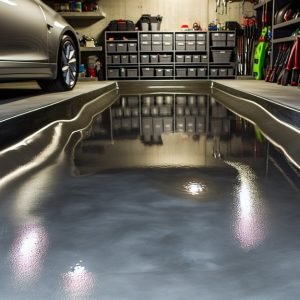Last Updated on October 30, 2025 by teamobn
Identifying the causes of water damage is the first step to protecting your home. Leaking appliances, roof issues, and clogged gutters often cause hidden drips. Storms and burst pipes can lead to major damage in minutes. Acting fast helps prevent mold, odors, and costly repairs.
Contents
Sources of Water Damage
Identifying where water originates helps prevent costly repairs. Leaks and failures often start in hidden spots.
Common household appliance leaks
Appliances like dishwashers and washing machines can spring leaks when hoses crack or connections loosen. You might not spot a slow drip until water pools under the unit or starts staining your floor. Over time that moisture can lead to mold, rot, and even structural damage if left unchecked.
Where to look for leaks:
- Under and behind washing machines
- Beneath dishwashers at the door seal
- Around water supply valves and hose fittings
Inspect appliance hoses every few months. Replace any hose showing cracks or bulges. Clean door gaskets on dishwashers to keep seals tight.
Air conditioning and water heater failures
Air conditioners produce condensation that drains away, unless the drain line clogs or the pan rusts through. A blocked line can overflow and leak into ceilings or walls. Water heaters also corrode from the inside out. Rust collects at the tank bottom and can eat through the metal shell.
Where to look for leaks:
- At the base of the water heater tank
- Along the AC condensate drain line
- Inside the drip pan under the AC unit
Have your AC serviced annually to clear lines and replace filters. Flush your water heater once a year to remove sediment and extend its life.
Roof leaks and clogged gutters
A damaged roof allows rainwater to seep into attic spaces and ceiling cavities. Missing or broken shingles leave the underlayment exposed to the elements. Clogged gutters force water to spill over and run down exterior walls. That water can pool at the foundation or soak into siding.
Where to look for leaks:
- In attic rafters and ceiling seams
- Around roof flashing and vent pipes
- At the front edge of clogged gutters
Clear gutters of leaves and debris at least twice a year. Replace missing shingles and seal any cracked flashing promptly.
Burst pipes and plumbing malfunctions
Pipes can burst when water freezes or if corrosion weakens the wall. A sudden burst releases gallons of water and can flood rooms in minutes. Even slow drips from a pinhole leak waste water and can lead to damage over time. Plumbing joints and valves wear out and may spring small leaks.
Where to look for leaks:
- Behind walls near pipe runs
- Under sinks and around P-traps
- Near water shutoff valves and joints
Insulate pipes in unheated areas to prevent freezing. Have a plumber inspect aging pipes every few years to catch corrosion early.
Storm, flood, and natural disaster damage
Severe weather can overwhelm drainage systems and force water into basements or ground-level rooms. Floodwaters carry contaminants that stain drywall and ruin flooring. High winds can tear off roofing materials and open gaps for rain to enter. Storm surges and heavy rains may breach flood barriers around your home.
Where to look for leaks:
- At foundation cracks and basement walls
- Around garage doors and ground-level windows
- Under siding and around exterior vents
Elevate utilities and install backflow valves if you live in a flood-prone area. Keep sandbags or flood barriers on hand for advance storm warnings.
How to find reliable water damage repair near me
Finding a trustworthy local service saves time and stress. When water damage strikes, you need a team that shows up fast, does the job right, and respects your home. Whether it’s a small leak or a major flood, having experts nearby makes all the difference.
If you’re searching for “water damage repair near me,” here’s how to make sure you’re hiring the right professionals.
Verify Credentials
Start by checking if the company is licensed and insured in your area. This protects you from liability and ensures the technicians understand local building codes and safety standards. Certified professionals—especially those trained by organizations like the IICRC (Institute of Inspection,
Cleaning and Restoration Certification)—use proven methods and stay current with the latest restoration techniques. Don’t hesitate to ask for proof of license and insurance before agreeing to anything. A legitimate company will always provide it upfront.
Read Customer Reviews
Online reviews offer valuable insights into how a company treats its customers and handles real-world situations. Look for recurring positive comments about fast response, professional conduct, and thorough cleanup.
Also, pay attention to how the company handles complaints. If multiple reviewers mention poor communication, missed deadlines, or surprise fees, it’s a red flag. Check Google reviews, Facebook pages, and specialized platforms like Angi or HomeAdvisor. A good reputation in your area is a strong sign you’re dealing with a reliable business.
Ask About Response Time
Water damage gets worse with every passing hour. Mold can begin to grow within 24–48 hours, and hidden moisture can quickly ruin walls, flooring, and insulation. That’s why choosing a company that offers 24/7 emergency service is crucial.
Ask how soon they can get to your property. Many reputable companies guarantee same-day or even same-hour service for local calls. Speedy arrival can mean the difference between a minor fix and major reconstruction.
Confirm Warranties and Guarantees
A written warranty signals that the company stands by its workmanship and materials. Some providers offer satisfaction guarantees, while others cover specific repairs for a fixed period, often one to five years.
Make sure these promises are clearly explained in your service agreement. Verbal assurances aren’t enough. Insist on documentation that outlines what’s covered, how long it lasts, and what actions may void the warranty. This helps you avoid disputes and gives peace of mind knowing you’re protected if problems resurface.
Get a Detailed Estimate
Before any work begins, request a detailed written estimate. It should include line-item costs for labor, materials, equipment use, and any potential add-ons. This makes it easier to compare bids and avoid hidden fees.
Reliable contractors will walk you through the quote and answer your questions. If a company pressures you to sign quickly or refuses to provide an estimate, that’s a warning sign. Transparent pricing is a basic expectation when dealing with something as serious as water damage restoration.
By verifying, reviewing, and comparing local options, you’ll find a team that delivers real value, not just a quick patch job. With water damage, fast action is critical, but so is smart decision-making. A qualified local expert can get your home back to normal and help prevent future problems.
Water damage restoration process explained
Understanding each step in the water damage restoration process helps you stay informed and reduces anxiety during a stressful time. Restoration work isn’t just about drying out your space. It’s a structured process that ensures your home is safe, clean, and fully repaired.
Knowing what to expect from the moment a technician arrives to the final walkthrough gives you confidence in the work being done.
Initial Assessment
The process begins with a thorough inspection. Trained technicians examine the affected areas using moisture meters, thermal imaging cameras, and visual checks. This helps them determine the extent of the water damage and identify any hidden moisture behind walls, under floors, or inside ceilings.
They assess the type of water involved—clean, grey, or black—which affects how the area is treated. Based on this information, the team creates a restoration plan tailored to your home’s condition. This step is critical in preventing future issues like mold growth or structural weakening.
Water Extraction and Drying
Once the plan is approved, the team begins water removal using high-powered pumps, vacuums, and extractors. The goal is to remove as much standing water as quickly as possible to reduce the risk of long-term damage.
After extraction, industrial-grade fans and dehumidifiers are set up to dry out carpets, subfloors, wall cavities, and other porous materials. This drying phase can take several days, depending on the severity of the damage and the materials involved. Technicians monitor moisture levels daily to ensure all areas reach safe humidity targets before moving forward.
Cleaning and Sanitizing
Water damage often brings contaminants, especially in cases involving grey or black water. That’s why cleaning and disinfecting come next. Restorers use antimicrobial treatments on all affected surfaces to kill bacteria and prevent mold and mildew. Items like carpets, upholstery, and curtains may be professionally cleaned or discarded if they can’t be safely restored.
This phase also includes odor removal. Techniques like fogging and ozone treatment are used to eliminate any musty or unpleasant smells left behind by moisture and mildew. A thorough cleaning protects your health and creates a fresh environment for the rebuilding phase.
Repairs and Restoration
Once everything is dry and sanitized, repair and reconstruction work begins. This can range from patching drywall and repainting walls to replacing entire sections of flooring or cabinetry. If structural components were compromised, professionals will reinforce or rebuild as needed.
Skilled tradespeople ensure that the materials used match the original appearance and function of your home. The goal is to return your space to its pre-damage condition—or even better. Some homeowners take this opportunity to upgrade certain finishes or improve during the rebuild.
Final Inspection
Before the job is considered complete, a final inspection is carried out. The restoration team reviews every area of work to confirm that moisture has been fully eliminated, repairs have been completed properly, and cleanliness meets professional standards. Moisture meters and thermal imaging may be used again to verify that no damp areas remain.
You’ll also receive documentation outlining the work performed, moisture readings, and any remaining recommendations. The final walkthrough gives you a chance to ask questions, voice concerns, and sign off with confidence knowing the job was done right.
Each phase of the water damage restoration process plays a vital role in protecting your home and health. From initial assessment to final inspection, a well-executed plan ensures your property is safe, dry, and fully restored.
Insurance coverage and claiming tips
Navigating insurance claims can feel overwhelming, especially during a water damage emergency. Good preparation helps speed up the process and improves your chances of full reimbursement.
- Review your policy: Understand what your homeowners or renters insurance covers. Check for specific limits on water damage and mold remediation. Be aware of exclusions like flood damage or sewer backups, which often require separate policies.
- Document all damage: Take clear photos and videos of every affected area before starting any cleanup. Capture details like water lines, warped flooring, stained walls, and damaged belongings. Strong documentation backs up your claim and shows the full extent of the loss.
- File claims promptly: Contact your insurer as soon as possible. Delayed filing can result in reduced compensation or outright denial. Always keep copies of claim numbers, emails, and forms submitted.
- Work with adjusters: Be present when the insurance adjuster visits your property. Point out all visible damage and provide your records. Ask questions to ensure you understand your coverage, timelines, and the next steps.
- Keep detailed records: Store receipts, invoices, and repair quotes in one place. Log every phone call and email with names, dates, and a conversation summary. These records can help resolve disputes or justify future expenses.
Conclusion
Water damage can come from many sources, including leaks, storms, or failing appliances. Identifying the origin early helps prevent mold, structural issues, and rising repair costs. The restoration process, from assessment to final inspection, ensures your home is safe, dry, and fully repaired. By acting quickly and choosing a reliable local service, you protect both your property and your peace of mind.
The extent of a water damage could be more than you can handle. To ensure if its a type of task you can tackle, check out our article on 7 home repairs a professional should left doing it.






